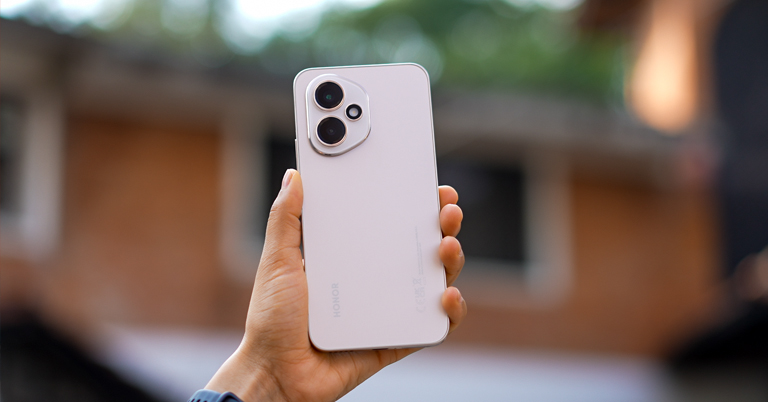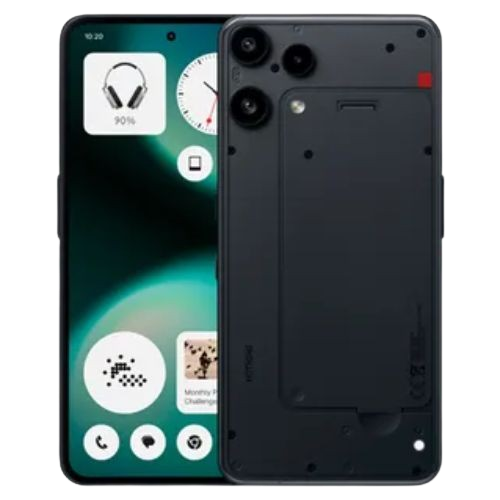No headings found
Why Trust Gadgetbyte?
At Gadgetbyte, we invest substantial hours into rigorously testing each product or service we review, guaranteeing that you make informed purchases. Learn more about our testing process.
Review Overview
Design
9/10
Display
9/10
Performance
8/10
Rear Camera
8/10
Front Camera
8/10
Battery
9/10
UI
8/10
Value for money
7/10
The Honor 400 offers a premium design, vibrant AMOLED display, and long battery life with fast charging. It performs smoothly for daily use and has useful AI features. The cameras are good but miss a telephoto lens. Overall, it’s a solid phone but slightly pricey compared to competitors.
The new Honor 400 series has launched in Nepal! Last year’s Honor 200 and 200 Pro were quite popular, they were hit models. And this time, the Honor 400 series includes three phones – Honor 400 Lite, Honor 400, and Honor 400 Pro. In this article, let’s talk about the slightly cheaper Honor 400.
The price of the Honor 400 in Nepal is Rs. 68,000 for the 12+512GB variant, the same as last year’s Honor 200. However, this time, Honor is offering an amazing pre-booking gift.
You get this smartwatch called Choice 2i worth Rs. 11,000, and Honor X7 Lite earbuds worth Rs. 2,082. So, freebies worth around Rs. 13,000. Plus, there’s a 0% EMI facility on this phone too. Earlier, EMI was only available for Samsung, but now almost all brands offer it. Also, you get 1-year screen replacement for free – if your screen breaks, you get one free replacement. So there are lots of offers, but the main question is – is the Honor 400 worth it at Rs. 68,000? At this same price range, you get Samsung’s hit model Galaxy A56… Vivo V50 is also available. So, which one to choose? I’ll tell you all this at the end, so let's begin this review by carefully looking at each categories.
Honor 400 Specifications
- Dimensions: 156.5 x 74.6 x 7.3 mm
- Weight: 184g
- Display: 6.55″ AMOLED curved display, 120Hz refresh rate, 1.07B colors
- Resolution: 2736 × 1264 pixels
- Durability: IP65 dust and water resistance
- Chipset: Qualcomm Snapdragon 7 Gen 3 (4nm)
- RAM: 12GB LPDDR5X
- ROM: 256GB or 512GB
- OS & UI: Android 15 with MagicOS 9.0
- Rear Camera: 200MP main (OIS), 12MP ultra-wide (f/2.2)
- Front Camera: 50MP (f/2.1)
- Battery: 6000mAh silicon-carbon cell
- Charging: 80W wired SuperCharge, 80W wireless, 5Wreverse charging
- Audio: Stereo speakers (no 3.5mm jack)
- Connectivity: eSIM 5G, Wi-Fi 6, Bluetooth 5.4, NFC, USB Type-C
- Security: In-display fingerprint sensor, Face unlock
Buy Honor 400 Here (Freebies worth Rs. 13,000)
Honor 400 Review
So starting off, inside the box, you get a charger – and it’s 80W. Brands like Samsung and Nothing don’t include it, but Honor does – that’s a good thing. You also get all the standard accessories.
Design
So, I will begin by telling you the two things I liked about this phone –
Its design and display! The phone’s design feels very premium. It has a boxy shape with rounded corners, a glass back, and classy color options. I liked that it feels handier than before – no curved edges, so no accidental touches either. Even the camera module looks better – before, it used to look like an egg.
So yes, design-wise, the phone is great. It also has an IP66 rating. The previous Honor 200 didn’t have any IP rating, so that’s a nice improvement. And even though this phone has a 6000mAh battery, it doesn’t feel too heavy or bulky. Honor was one of the first companies to adopt SiCa technology, and you get that here too.
Display
The display is also top-tier – it’s a 6.55-inch AMOLED screen with a 120Hz refresh rate and 10-bit color depth. So it's fairly color-accurate. And most importantly, it has 3840Hz PWM dimming, so even after long usage, it won't strain your eyes. HDR works across YouTube and OTT platforms too, and overall the viewing experience is very good – 9/10! You also get an in-display fingerprint sensor – it’s optical, not ultrasonic – but it’s fast. It’s placed slightly lower, so you’ll have to stretch your thumb a bit. If you have big hands, it won’t be an issue. One more thing – I didn’t keep the refresh rate in dynamic mode; I locked it to high (120Hz). In dynamic mode, sometimes the refresh rate drops, and the UI starts feeling a bit slow – hopefully, Honor will fix this in future updates.
OS and UI
Speaking of updates, Honor has committed to more updates this time. They’re offering 6 years of OS updates, which is good – almost like Samsung. Also, Honor’s UI is clean – no ads, very little bloatware – that’s good too. Still, honestly speaking, it’s a little behind Samsung’s OneUI or Nothing OS in terms of user experience.
Anyway, Honor is taking AI features seriously this time. They’re even marketing it as an AI phone from the beginning. In the camera, you get features like AI Eraser and AI Upscaler – and an AI Outpainting feature that expands images using generative AI. AI Face Tune includes different beautification options – if your eyes are closed, it will process and open them in the best way possible.
There’s even a built-in image-to-video converter, which gives convincing results.
You can select any image from the gallery and turn it into a 5–7 second video.
It takes 1–2 minutes to process, but the output is good. Honor also has its own AI video editor, which is good enough for basic Instagram or TikTok videos – you won’t need third-party apps.
The main highlight is the Deepfake Detection feature – no free AI tool currently does this. During video calls, the phone can detect if the person is deepfaked and tell you whether it’s real or not.
Performance and Haptics
Now let me talk about the three things that I found disappointing or could have been better.
First – the haptics aren’t very good. It has such a good display, but the vibration feedback feels cheap and buzzy.
Second – Honor has not improve in the performance segment compared to last year.
Yes, Snapdragon 7 Gen 3 is the best available in this price range, but to stand out in the competition, they could’ve gone with 7+ Gen 3. In fact, the Chinese variant of this phone has the newer SD 7 Gen 4.

Now we know how SD 7 Gen 3 performs – it’s smooth for regular tasks, and
for gaming: PUBG runs at 60fps, Genshin Impact at High + 30fps – which is decent.
Camera
Third – I’m not very happy with the cameras, but that’s mostly because I had high expectations. Last year’s Honor 200 had a telephoto lens that took amazing portraits. But this time, Honor removed the telephoto lens.
Now, the main camera is 200MP, and there’s a 12MP ultra-wide lens.
the main camera can take good portraits, but you miss the unique perspective that a telephoto provides.
Still, you can take social-media-worthy portraits from 2x to 4x zoom. Skin tones are good, contrast has a dramatic look – so that’s nice. It still has those heavy filter options from before – I personally liked the black & white one. The normal photos from the main camera have great contrast and sharpness. Colors are vibrant – good for travel shots.
Even night-time shots come out sharp without using night mode. In fact, under good lighting, normal mode performs better than night mode.
I liked the selfies too – they are slightly smoothened, but natural details are preserved, and colors look good.
The ultra-wide photos looked more natural to me – although with less detail (since it’s only 12MP), the dynamic range is surprisingly good.
You can even shoot 4K 30fps videos from the ultra-wide lens, just like the main lens –
and you can switch lenses mid-shoot, which many phones don’t allow.
The video quality is good – not shaky, thanks to the EIS+OIS combo, and it handles color and highlights well. So I have no complaints about videography. Even selfie videos support 4K 30fps and are stable. My only complaint in the video department is that at night, videos get noisy, and the ultra-wide camera lacks detail in low light. But daytime videos are really good!
Battery and Charging
Lastly, about battery life – under normal usage, this phone gives up to 2 days of battery.
Even with heavy usage, I still had 10–15% left at the end of the day – so that’s good. Charging takes about 1 hour with the included 80W charger.
Honor 400 Review: Pros and Cons
Pros
- Clean, minimal design
- Excellent display quality
- Great battery life
- Clean software with AI features
Cons
- No zoom lens
- Poor low-light video
- Feels similar to predecessor
- The price could be lower
Honor 400 Review: Conclusion
To sum it up, the Honor 400 is a solid phone. It holds its own against competitors – the design and display are great. Performance is standard. I missed the telephoto lens, but the overall camera performance is still good. Battery life is great, and you don’t need to buy a separate charger.
If you’re someone who uses a lot of AI features, this phone offers plenty –
the deepfake detection feature is especially impressive. That said, the price could’ve offered better value – if it was around Rs. 60,000–62,000, this would’ve been one of the best options out there.
Article Last updated: June 10, 2025









